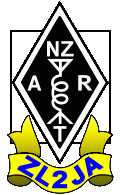Wanganui Branch History
INDEX < Prev 1 2 3 4 5 6 7 8 9 10 Next > ..... 40
The set then consisted of two U.V. 201 tubes using a Colpitt’s circuit with a magnetic modulator. The operators did not know it was a Colpitt’s circuit, but blindly followed the diagram accompanying the set of parts. As may be expected, difficulties were many. First of all the set would not oscillate at all. This was put down to the tubes, so a 5-watt Radiotron was obtained: Still no results. The plate supply was then about 210 volts from dry cells. A small generator giving about 150 to 200 volts, driven by a water motor, was put in series with the dry cells, and once more the set was tried. The only result was that the plate of the tube became nearly white hot. It was then decided that the inductance supplied was too small and several others were tried. At last, success was obtained, and the set oscillated. Modulation was the next problem. The magnetic modulation did not have the slightest, effect which was really quite reasonable since it was marked 3.5 to 5 amperes. It was therefore returned and a modulation transformer purchased. With this, modulation was obtained, using grid control. Signals were actually heard about a mile away and everyone was greatly pleased. The radiation must then have been about .05 to .1 of an ampere, and the percentage of modulation was negligible. It was decided to erect a new aerial, and permission was obtained to use a high tree on a neighbouring property for one mast. The other mast was erected on the roof, and a four-wire cage type aerial about 120 feet long put up.
 The old aerial was used as a counter-poise but owing to the configuration of the building it was impossible to make this more than about sixty feet long, and it had to slope down from the top of a thirty-foot wall to the ground. With the new aerial and counterpoise great improvement was found and reports of reception were received from Marton and Levin. Further improvements were effected in the apparatus and, in July, a telegram was received from Dunedin reporting good reception on one valve. This put new heart into the operators and several changes were proposed to improve matters. First a transformer was constructed to transform the town A.C. supply down from 230 volts to about 10 volts for the filament supply. Previously borrowed accumulators were used and the trouble of carrying them up and down was now obviated. A new inductance of the pancake type was also constructed from the copper strip from the alternator filled coils of an old Ford car. This somewhat improved radiation and certainly facilitated tuning.
The old aerial was used as a counter-poise but owing to the configuration of the building it was impossible to make this more than about sixty feet long, and it had to slope down from the top of a thirty-foot wall to the ground. With the new aerial and counterpoise great improvement was found and reports of reception were received from Marton and Levin. Further improvements were effected in the apparatus and, in July, a telegram was received from Dunedin reporting good reception on one valve. This put new heart into the operators and several changes were proposed to improve matters. First a transformer was constructed to transform the town A.C. supply down from 230 volts to about 10 volts for the filament supply. Previously borrowed accumulators were used and the trouble of carrying them up and down was now obviated. A new inductance of the pancake type was also constructed from the copper strip from the alternator filled coils of an old Ford car. This somewhat improved radiation and certainly facilitated tuning.
Reports were received about this time from places as far south as Waimate, and as far north as Auckland. Mr. Bell, of Palmerston South, was also good enough to give us a frank report, which helped us considerably. All reports seemed to agree that the modulation of speech was good, but that the music was “tinny.” As we were using an extremely ancient gramophone, this was not to be wondered at. Reports also showed that “swinging” was bad at times. This was put down to grid control, so it was decided to change over to the Heising system of choke control.
Tramways to the Rescue!
At the same time a lead from the tramway supply of 550 volts was obtained, and this ended our plate supply troubles. Very little difficulty was found in making the new system work, but modulation was at first rather bad. Various chokes and microphones were tried until the best results were obtained. Reports immediately showed that swinging had been practically eliminated and modulation improved by the change to choke control. If anything the percentage of modulation was somewhat reduced, but this was compensated for by the above benefits. The circuit used at that point was as shown in the diagram herewith. Two oscillator and one modulator tubes were used, all 5 watt Radiotrons. The input is about 30 to 40 watts to the oscillator tubes, and the radiation about 1.25 to 1.5 amps. The circuit is not exactly orthodox, but as it gave quite good results it was not changed. The radiation could have no doubt been considerably improved by a better counterpoise, but that was not possible where they were situated at that time. The choke coil used was 1 lb. of 34 wire wound on a core of soft iron wire 1 inch in diameter and about six inches long.







